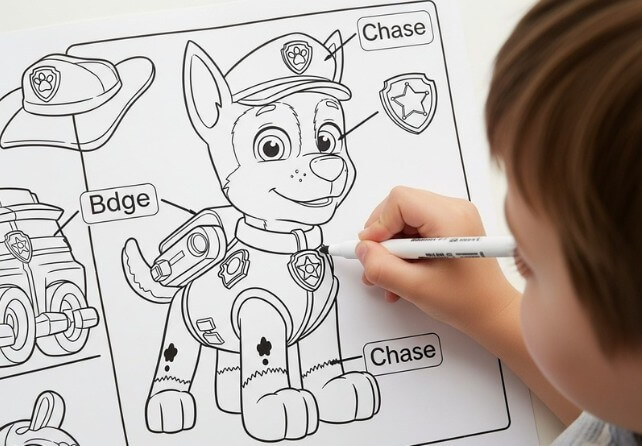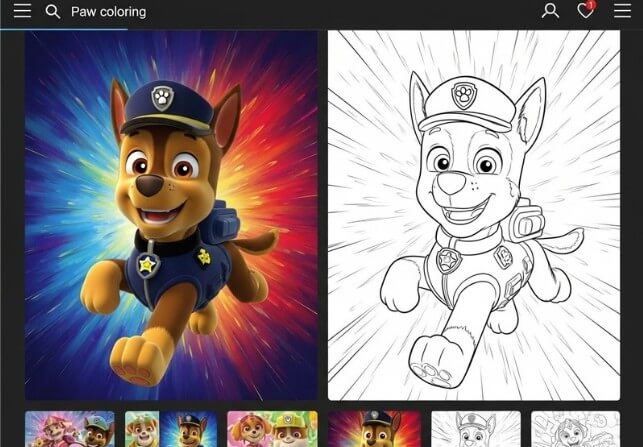How to Use Paw Patrol Coloring Pages for Kids’ Learning?

If your child loves Marshall, Chase, Skye, Rubble, and the rest of the rescue team, you may already have a folder full of paw patrol coloring pages at home. But what many parents and teachers do not realize is that these coloring pages can be more than just a fun activity. They can help kids learn in simple, enjoyable ways. Coloring pages are not just about filling shapes with crayons. They can support learning skills like reading, writing, math, thinking, observation, creativity, problem-solving, and even emotional development. When used the right way, Paw Patrol coloring pages become a powerful tool for early education.
This article explains how you can use these pages to teach kids without making them feel like they are doing schoolwork. With simple activities, guided tasks, and easy methods, Paw Patrol coloring pages can turn into learning sheets that help with brain growth and development. The goal here is to show you everything you can do with these pages at home, in school, or during daily routine activities.
Why Coloring Helps Kids Learn
Before learning how to use these pages for teaching, it helps to understand why coloring is powerful for young children.
Coloring Helps with Fine Motor Skills
When children color inside the lines, their small muscles develop strength and control. This helps with writing, cutting, and holding tools.
Coloring Helps the Brain Focus
Filling shapes slowly trains the brain to concentrate. Kids learn patience, attention, and calmness.
Coloring Builds Hand-Eye Coordination
Kids must guide their hands based on what their eyes see. This skill is important for sports, writing, typing, and drawing.
Coloring Helps with Creativity
Children learn color choices, patterns, and how to imagine things on their own.
Coloring Builds Confidence
When a child finishes a page, they feel proud. This grows confidence and encourages them to try more tasks.
How Paw Patrol Coloring Pages Support Early Learning
Paw Patrol characters are perfect for learning because each pup has a unique role. Kids relate to their personalities, which makes learning more fun.
Chase – Police and safety
Marshall – Firefighting and bravery
Skye – Flying and adventure
Rocky – Recycling and problem-solving
Rubble – Building and teamwork
Zuma – Water rescue
Everest – Snow rescue
With these characters, you can create different learning activities around safety, teamwork, kindness, bravery, and problem-solving.
Using Coloring Pages for Reading and Vocabulary
Many children learn words faster when they see pictures. Paw Patrol coloring pages help with reading in these ways:
Labeling Activities
After kids color a page, ask them to label simple words like:
pup
car
truck
sky
fire
snow
boat
hat
badge
You can write the words lightly in pencil and ask the child to trace them.
Character Names
Teach kids to recognize names like:
Chase
Marshall
Skye
Rubble
Rocky
Kids get excited when they can write the name of their favorite pup.
Storytelling
After coloring, ask the child:
“What is the pup doing?”
“What will happen next?”
“Where are they going?”
Children learn speaking skills, imagination, and sentence building.
Using Coloring Pages for Early Math
Many parents never think of using coloring pages for math, but it works wonderfully.
Counting
Ask kids to count:
Badges
Stars
Wheels
Helmets
Hats
Clouds
Paws
You can mark the items and let the child say the number.
Number Coloring
Write numbers inside different spaces and ask kids to color:
1 = red
2 = green
3 = blue
4 = yellow
This teaches number recognition.
Shape Learning
Many Paw Patrol vehicles include shapes like:
circles
rectangles
squares
ovals
Ask the child to identify shapes around the characters.
Comparing
Ask questions like:
“Which pup has a bigger hat?”
“Which vehicle has more wheels?”
This builds early math thinking.
Using Coloring Pages for Writing Practice
Writing becomes easier when kids warm up their hands through coloring. After coloring:
Tracing
Write simple sentences such as:
“This is Chase.”
“Skye can fly.”
“Marshall helps people.”
Kids can trace the letters and learn writing patterns.
Copying
Older kids can write the sentences on their own by looking at what you wrote.
Story Summaries
Ask kids to write 1–2 sentences about the page they colored.
Using Coloring Pages for Emotional Learning
Paw Patrol teaches teamwork, kindness, and bravery. These themes help children understand feelings and behavior.
Talk About Emotions
Ask:
“How do you think Chase feels in this picture?”
“Why does Marshall look happy?”
Kids learn to understand emotions in themselves and others.
Talk About Problems
“What problem do you think the pup is solving?”
“How can we help someone today?”
Kids learn kindness and empathy.
Using Coloring Pages to Teach Real-Life Lessons
You can connect the characters’ roles to real-world learning.
Safety Lessons
Chase teaches about:
traffic safety
rules
listening
helping others
Use his coloring pages to start these conversations.
Fire Safety
Marshall helps kids understand:
fire trucks
fire alarms
calling 911
staying calm
Recycling and Environment
Rocky teaches kids why recycling matters and how to take care of the planet.
Building and Tools
Rubble helps kids learn:
construction
tools
teamwork

Using Coloring Pages for Classroom Learning
Teachers can use Paw Patrol pages in many classroom activities.
Group Work
Students can color different characters and then present what they learned.
Learning Centers
One table can be the coloring station. Kids move from one center to another, learning different skills.
Art and Craft Projects
You can cut characters out, paste them on charts, and build group posters.
Behavior Charts
Teachers can use Paw Patrol characters as reward trackers.
Using Coloring Pages for Home Learning
Parents can turn coloring time into learning time without pressure.
Daily Quiet Time
Coloring calms children after school.
Homework Breaks
Ten minutes of coloring refreshes the brain.
Weekend Activities
Turn coloring pages into mini projects:
color
cut
paste
decorate
Sibling Activities
Older kids can help younger kids color.
How to Turn Coloring Pages into Creative Projects
Kids enjoy projects that mix coloring with hands-on activities.
Make a Paw Patrol Book
Color 10 pages
Staple them
Write a title
Make Character Stands
Color
Cut
Glue on cardboard
Stand them up
Create Posters
Use different pages to make a wall poster about teamwork.
Make Flashcards
Cut small coloring images and write simple words below them.
Using Paw Patrol Pages for Learning Colors
Many kids struggle with color recognition. Paw Patrol coloring pages help because the characters already have signature colors.
Chase = blue
Marshall = red
Skye = pink
Rocky = green
Zuma = orange
Rubble = yellow
This makes it easier for kids to remember.
Using These Pages to Teach Patterns
Ask children to color:
hat = red, blue, red, blue
badge = yellow, green, yellow, green
Patterns help with early math skills.
How to Choose the Right Coloring Page for Learning
Not all pages are good for learning. Here is how to select the right ones.
For writing practice
Choose pages with open space.
For counting
Choose pages with many small parts.
For storytelling
Choose action scenes.
For color learning
Choose pages with characters and vehicles.
How to Organize Learning Activities with Coloring Pages
To make coloring part of regular learning, keep things organized.
Create folders:
reading
math
shapes
writing
stories
Make different sets for different skills.

Tips to Make Learning Fun for Kids
Kids learn best when the activity feels fun.
Let Them Choose the Page
Choice makes kids feel independent.
Use Bright Crayons
Kids enjoy using many colors.
Color Together
Children learn by watching adults.
Display Their Work
Put finished pages on walls or doors.
How Paw Patrol Coloring Pages Help Different Age Groups
Each age group learns differently. Here’s how to use the pages for each group.
Ages 2–3
Coloring simple shapes
Learning colors
Naming characters
Ages 4–5
Tracing
Counting
Writing simple words
Ages 6–7
Story writing
Problem-solving
Color-by-number activities
Conclusion
Paw Patrol coloring pages are a fun, simple, and powerful way to support early learning at home and in school. By using these pages for reading, writing, math, storytelling, creativity, emotional learning, and real-life lessons, children learn naturally and enjoyably. The characters help kids stay interested, focused, and excited about new skills. With the right activities and a bit of guidance, coloring becomes more than just a hobby; it becomes a full learning tool that helps kids grow, think, and create. And if you want even more fresh and creative printable designs to support learning, you can explore Sketchy Tones for new ideas and pages.



